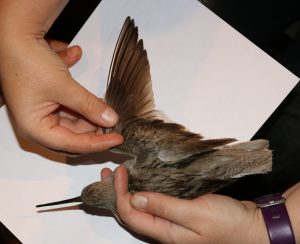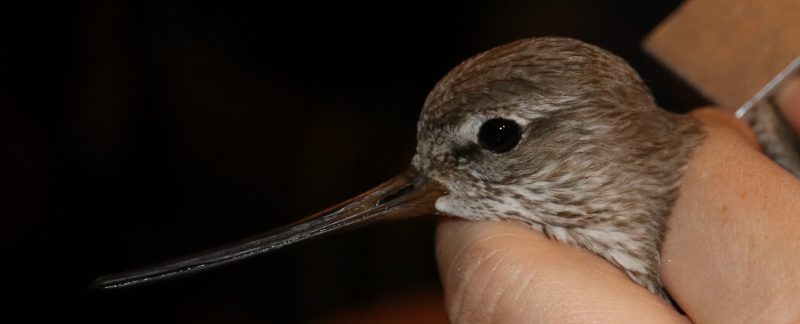Many of us really look forward to our mist-netting sessions for waders as we so love being out on a saltmarsh at night. Setting mist nets on a marsh is spectacular in itself with tall lines of nets stretched across the landscape, but there is nothing to beat the atmosphere when it gets dark. As the light fades and then the tide comes in you start to hear the eerie sounds of waders calling as the water moves them up off the mudflats. If there is enough light you might start to see them flying over the marsh. If you are really lucky, there will also be shooting stars, phosphorescence as you walk across the marsh (feeling like Gandalf every time you lean on your furling stick), or even fireworks in a nearby town.
We mist net regularly on suitable tides (high enough to bring the birds onto the marsh and dark enough to use mist nets) throughout the year, but the most exciting trips are generally in the autumn when the beautiful juvenile birds are just back and you can almost guarantee phosphorescence. As always with mist netting there is anticipation of what you might catch, with the autumn trips sometimes providing less usual birds, such as the Ruff we caught in 2017, Curlew Sandpipers in ‘good’ years and the Broad-billed Sandpiper many years ago. As we extract in the dark you identify the birds by feel, size and shape, and with a little help from any ambient light, every bird is small adventure.

Terek Sandpiper being examined, by Guy Anderson
Our ‘bread & butter’ (and what we are aiming to catch for our regular monitoring work) when mist-netting is generally Dunlin and Redshank. On our August trip this year, we had a very successful session of mist-netting with a large team, catching over 200 birds, Redshank were by far the most common with an excellent mixture of adults and birds of the year. We also got a good sample of Dunlin (mainly juveniles) and small numbers of seven other species, one of which was a big surprise – an adult Terek Sandpiper – well away from it’s normal flyway! As about a third of the team had caught Tereks on the East Asian-Australasian flyway, we were in no doubt what it was – well you wouldn’t be anyway, would you – what else has such a steep forehead and a bill like that? We checked for ring size (we used C2), ringed and processed the bird and took limited photographs and a description (later submitted to BTO and the BBRC) before releasing it back on the marsh. We believe it to be the first Terek Sandpiper to be caught and ringed in Britain & Ireland – indeed only a few (or none) are seen here each year. It was quite fat, so was likely passing through heading south. We can’t help wondering what will happen to it now – will it make it back onto the correct flyway? We hope so and wish it well in it’s unusual travels.

